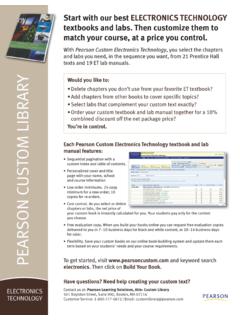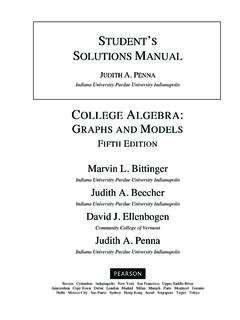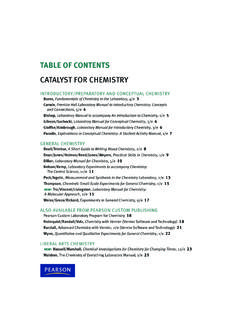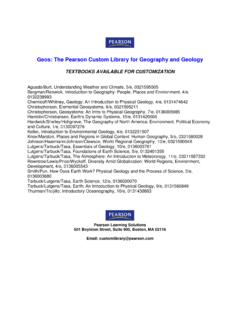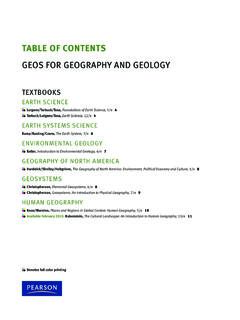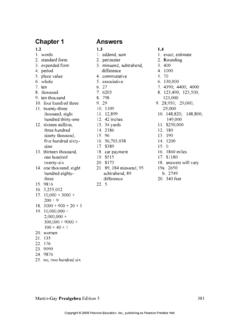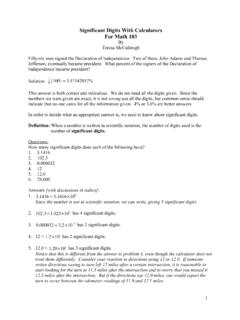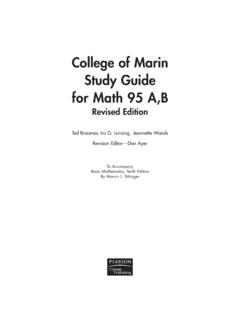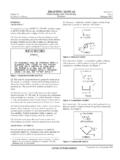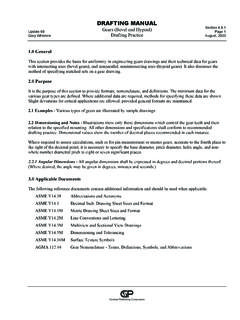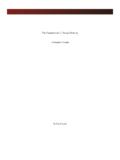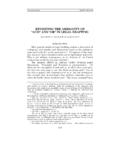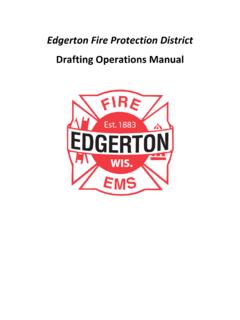Transcription of The Little, Brown Handbook - Pearson
1 The little , BrownHandbookTENTH EDITIONH. Ramsey FowlerSt. Edward s UniversityJane E. AaronJanice OkoomianBrown UniversityNew York Reading, Massachusetts Menlo Park, California Harlow, EnglandDon Mills, Ontario Sydney Mexico City Madrid AmsterdamINSTRUCTOR SRESOURCE MANUALTO ACCOMPANYIRM 10e_Final_ppi-iv 6/18/06 7:09 PM Page iInstructor s Resource Manual to Accompany The little , Brown Handbook ,Tenth EditionCopyright 2007 Pearson Education, rights reserved. Printed in the United States of America. Instructors may re-produce portions of this book for classroom use only. All other reproductionsare strictly prohibited without prior permission of the publisher, except in thecase of brief quotations embodied in critical articles and visit our Web site at : 0-321-43544-3 1 2 3 4 5 6 7 8 9 10 DOC 09 08 07 06 IRM 10e_Final_ppi-iv 6/27/06 1.
2 05 PM Page iiiiiDesigning and Teaching Composition Courses1 Teaching Writing as a Process2 Using The little , Brown Handbook 10 Working with Student Writing30 Using Collaborative Learning with the Handbook52 Using Computers to Teach Writing66 Teaching Writing to ESL Students101 The Writing Process115 Assessing the Writing Situation116 Developing and Shaping Ideas127 Drafting and Revising140 Writing and Revising Paragraphs153 Designing Documents171 Reading and Writing in College177 Writing in Academic Situations178 Studying Effectively and Taking Exams181 Forming a Critical Perspective185 Reading Arguments Critically199 Writing an Argument209 Reading and Using Visual Arguments219 Grammatical Sentences225 Understanding Sentence Grammar226 Case of Nouns and Pronouns247 Verbs252 Agreement263 Adjectives and Adverbs269 Clear Sentences275 Sentence Fragments276 Comma Splices and Fused Sentences281 Pronoun
3 Reference286 Shifts290 Misplaced and Dangling Modifiers294 Mixed and Incomplete Sentences300 Effective Sentences305 Emphasizing Ideas30623522212019181741615141312311109 8762543211 CONTENTSIRM 10e_Final_ppi-iv 6/18/06 7:09 PM Page iiiUsing Coordination and Subordination312 Using Parallelism320 Achieving Variety324 Punctuation331 End Punctuation332 The Comma335 The Semicolon347 The Apostrophe352 Quotation Marks356 Other Punctuation Marks360 Mechanics367 Capitals368 Underlining or Italics371 Abbreviations374 Numbers376 Effective Words379 Using Appropriate Language380 Using Exact Language386 Writing Concisely393 Using Dictionaries398 Spelling and the Hyphen403 Research Writing409 Planning a Research Project410 Finding Sources418 Working with Sources426 Avoiding Plagiarism and Documenting Sources435 Writing the Paper439 Using MLA Documentation and Format443 Two Research Papers in MLA Style447 Writing in the Academic Disciplines451 Working with the Goals and Requirements of the Disciplines452 Reading and Writing
4 About Literature455 Writing in Other Humanities462 Writing in the Social Sciences465 Writing in the Natural and Applied Sciences470 Special Writing Situations475 Writing Online476 Public Writing482 Oral Presentations488565554115352515049104847 4645444342941403938378363534337323130292 8276262524ivContentsIRM 10e_Final_ppi-iv 6/18/06 7:09 PM Page ivDesigning and TeachingComposition CoursesCHAPTER1 Teaching Writing as a ProcessCHAPTER 2 Using The little , Brown HandbookCHAPTER 3 Working with Student WritingCHAPTER 4 Using Collaborative Learning with the HandbookCHAPTER 5 Using Computers to Teach WritingCHAPTER 6 Teaching Writing to ESL StudentsThese chapters appear only in this Instructor s Resource Manual and the Instructor s Annotated EditionIRM 10e_INTRO_Final_pp01-114 6/18/06 7:09 PM Page 12 Teaching Writing as a ProcessWRITING AS A HOWD rawing on the results of three decades of research into the compos-ing processes of writers, most writing instructors now emphasize the howof writing.
5 While theorists such as Lester Faigley and Susan Miller havepointed out the limitations of trying to define systematically what happenswhen a writer sits down to compose a work, most writing teachers andtheir students have effectively adapted a focus on the processes throughwhich students generate and revise their writing, rather than focusingsolely on a final product. This book is designed to support that focus onthe howsof writers agree that at least three components contribute to theprocesses they use most of the time: prewriting,the finding and exploring ofideas and the construction of plans for expressing them (in classical termi-nology, invention); drafting,getting the ideas down on paper and generatingsentences about them; and revising,reconsidering the ideas, the treatmentthey receive, the plans for expressing them, and the ways they are expressed(in classical terminology, arrangement, style,and to some extent, delivery).
6 Theories about the writing process have focused on the ways in whichwriters do the following: perceive and explore themselves and their worlds through the mediumof language; consider their subject matter as the occasion for interpretive analysisand as the testing ground for ideas and hypotheses; respond to, understand, and to some degree, invent their audiences;and position themselves in relation to writerly conventions, to institutionalrestraints, and to communities within and outside of the assumptions are based on the theories outlined AS AN EXPRESSIVE PROCESSMany theories of the writing process from the 1960s and 1970s focused onits expressive content, the attempts of writers to use language to capture andarticulate the unique vision of the writer. For instance, D. Gordon Rohmanand Albert O.
7 Wlecke argue that techniques such as meditative exercises,CHAPTER 1 IRM 10e_INTRO_Final_pp01-114 6/18/06 7:09 PM Page 2journal keeping, and the composition of analogies (called existential sen-tences ) help writers find a personal truth in even the most abstract of sub-jects. They argue that such prewriting techniques lead in a smooth andlinear fashion to drafting and revision as writers refine the expression of thetruth they tell. This privileging of self-discovery, what is sometimes calledthe expressionisticor romanticview of composing, is also held by PeterElbow, Ken Macrorie, William Coles, and Donald Murray, to name a few ofits most influential proponents. Elbow argues for the efficacy of freewritingand drafting in helping writers explore ideas before worrying about struc-ture and presentation.
8 Macrorie encourages students to use case histories of past experiences and to work from direct observation in order to gobeyond the obvious clich s, which he calls Engfish (because they stink ofinsincerity). Coles values prewriting because it allows students to exploremultiple relationships to readers and subjects (what he calls plural I s ).Murray emphasizes aspects of prewriting that cultivate surprise, originality,and new combinations of ideas that lead to personal expressionistic theory gives discovery of ideas primacy in the writ-ing process and sees the writer s personal vision as more important thanconventions and codes; its emphasis on pre- and freewriting is an attemptto give writers the power to control or even exploit conventions and expec-tations in the interests of conveying an original vision.
9 These beliefs havethus attracted criticism from those who believe that the teacher s responsi-bility is to show writers how to become part of a community, not how toput themselves outside it. However, the expressionists contributions toour understanding of the formative stages of prewriting and drafting andtheir respect for students as writing colleagues have benefited many teach-ers and theorists. Ann Berthoff s work is an interesting example of thatinfluence; she draws on the expressionistic emphasis by stressing thepower of the imagination to create relationships between ideas, but in Recognition, Representation and Revision she also develops an under-standing of revision as a nonlinear part of the composing process, anongoing reconsideration of those relationships.
10 Where many expression-ists might insist that pre-writing generates the ideas, that revision is theprocess of getting them right, and that editing is the radically separate taskof adjusting the etiquette of presentation (spelling, punctuation, and thelike), Berthoff and others view revision as a recursive process, as the mean-ingful reconsideration and development of ideas articulated through thegrammar of the paragraph and the AS A COGNITIVE PROCESSA second school of theories about the writing process is deeply rootedin psychology, particularly in studies of cognition. For such cognitivetheo-rists, protocols (detailed descriptions of how a document is produced)and draft analyses play a key role. One of the earliest such cognitive stud-ies is Janet Emig s.
